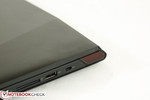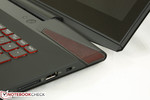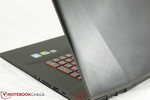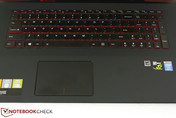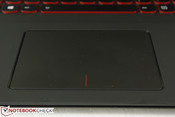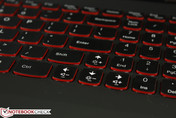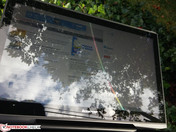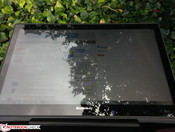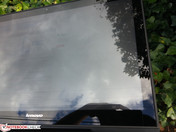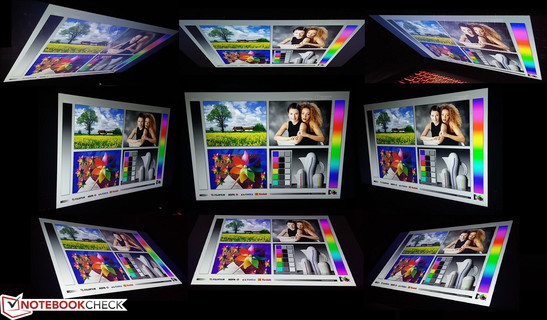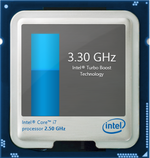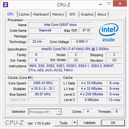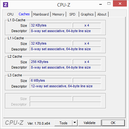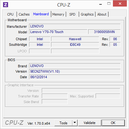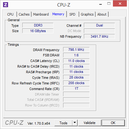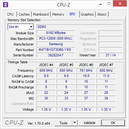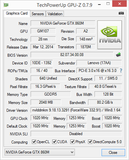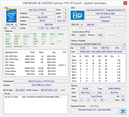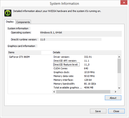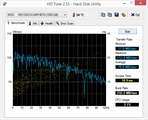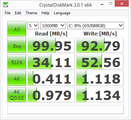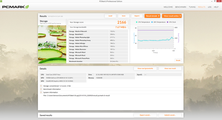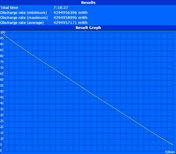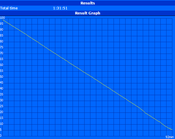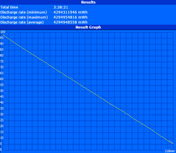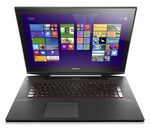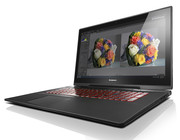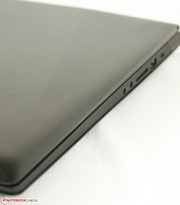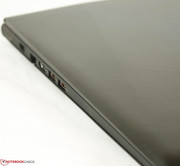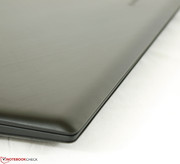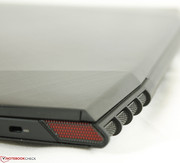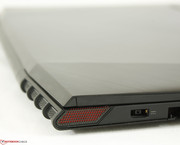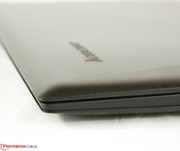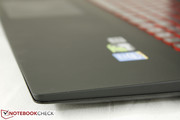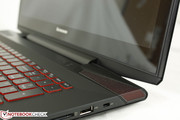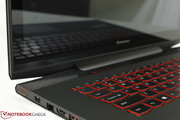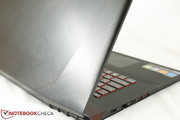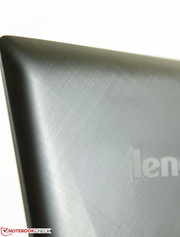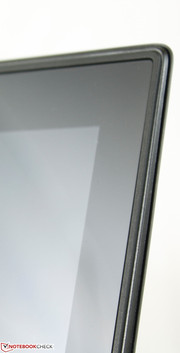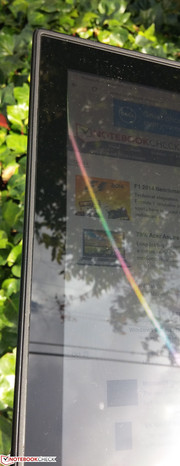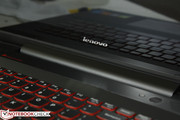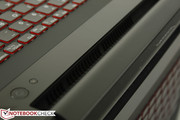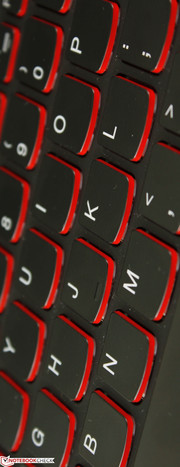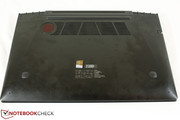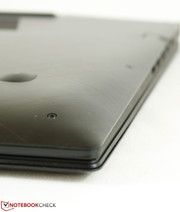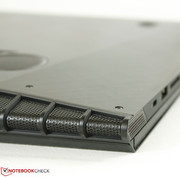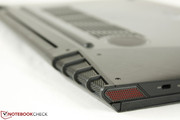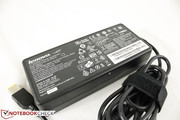Lenovo Y70 Notebook Review
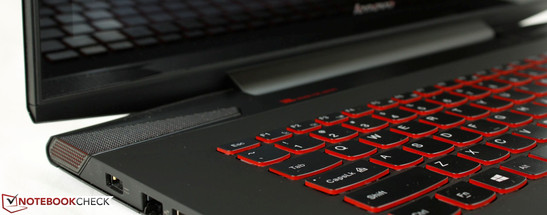
With the Y70 Touch on hand, we can finally complete our analyses on the trio of Lenovo’s Y Series that started with our original Y40 and Y50 reviews published earlier this year. As expected, the 17.3-inch Y70 gamer is the largest member of the family yet with its multi-touch 1080p IPS display, Core i7-4710HQ CPU, GTX 860M graphics, up to 16 GB DDR3L RAM and a 1 TB SSHD or dedicated SSD storage. With specs largely the same as its smaller siblings, the Y70 targets mainstream to hardcore gamers who aren’t satisfied with 14-inch or 15-inch screens.
The $1399 starting price pits the Y70 directly against other 17-inch gaming models like the Asus ROG G750 and MSI GT72 Dominator, while its stylish demeanor makes comparisons against the more expensive Aorus X7 v2 and the just released Acer Nitro V17 inevitable. With the recent launch of the GTX 970M and 980M still on the pricey side, there is no shame in settling for a GTX 860M to save on costs with a small sacrifice on performance. Can the Y70 find a market in this post GTX 900M world?
Case
Physical qualities of the chassis are nearly identical to the Y50, all the way down to the jet black rubberized palm rests, brushed aluminum lid, red trims, and metal maintenance hatch. If compared to the Y40, the Y70 drops the carbon fiber checkerboard texture and brushed aluminum base. More details and characteristics of these surfaces are consequently explored in our earlier reviews. Additional differences to the non-Touch Y40 and Y50 include an edge-to-edge glass display for much improved screen protection and aesthetics. However, the real question remains: Has the chassis been properly scaled up to accommodate the larger form factor?
Almost immediately we can see that the outer lid is now a bit more susceptible to pressure down the center. However, it’s worth noting that this is common on a large number of 17-inch gaming notebooks simply due to the larger surface area. Fortunately, the rest of the chassis holds up very well to depressions and warping, such as around the palm rests, on the center of the keyboard, and on the bottom of the notebook. Twisting of the base is also a non-issue, though the lid itself is not nearly as rigid. The display still wobbles slightly when typing and especially when readjusting, so it could have benefited from a tighter hinge.
Our Y70 model suffers from no manufacturing or shipping defects. This is not normally discussed in our reviews, but since our original Y50 came with a slightly damaged rear corner, we find it fitting to mention that the Y70 possesses no such issues. Even so, the rear ventilation grilles and hinge are plastic and feel like they belong on more inexpensive mainstream or budget models. The plastic around the corner ventilation grilles, for example, will easily creak. Since the Y70 does not incorporate a unibody design, these pieces can more easily chip or bend if the user is not careful when transporting the notebook. In this regard, we find the thicker builds of the Asus G750, iBuyPower Valkyrie CZ-17, and Alienware 17 to be noticeably more robust.
The advantages of the Lenovo lie instead on visual appeal and thickness. There is no denying the thinness and weight of the Y70 at just 25.9 mm and 3.5 kg, respectively, compared to other 17-inch gamers like the nearly 50 mm Asus G750 and MSI GT72. Lenovo are clearly aiming for a thinner and lighter solution than the competition with the 2014 Y Series after experimenting with SLI solutions on the previous generation Y models. Nonetheless, our comparison table below shows that there are a number of other gaming notebooks that come in a hair thinner than the Y70.
Connectivity
Available ports are identical across the Y Series, including on the smaller 14-inch Y40. Thus, we refer to our previous reviews for a more comprehensive overview of the physical ports. Compared to competing 17-inch models, the Y70 could have included multiple video-out ports and more than 3x USB ports, which is substandard for a notebook this size.
Communications
WLAN is provided by an Intel wireless-AC 3160 half-mini PCIe card with integrated Bluetooth 4.0 support. Though it is a dual band (2.4 GHz and 5 GHz) module, the card is only a 1x1 configuration, meaning a maximum transfer speed of 150 Mbps and 433 Mbps on wireless-n and wireless-ac networks, respectively. High-end gaming machines typically carry 2x2 WLAN options or even gigabit options like certain Asus ROG models for faster speeds.
There are no GPS, SIM, or WWAN options as expected from a dedicated gaming notebook.
Accessories
Similarly, accessories are limited to generic USB devices and other official items sold by Lenovo as the system lacks a dedicated docking port. Notably, the manufacturer includes a slim USB DVD burner in the same box with the Y70.
Warranty
Lenovo continues to offer one of the more comprehensive protections plans on top of the usual 1-year base warranty. Users can opt-in for up to 3 years of coverage with in-home repairs and accidental damage protection for $239 or less.
Input Devices
Keyboard
The AccuType chiclet keyboard on the Y70 (34 cm x 10 cm) is essentially identical to the keyboard found on the Y50. Like its smaller brother, the red backlit keys are shallow in travel and the feel of the keys can take some time to become accustomed to. The tactile feedback, however, has been improved a bit to reduce that sponginess feel on the Y50.
Another complaint is the size of the NumPad keys, which are made smaller than the QWERTY keys. It would have been useful to exploit the larger surface area available by having the NumPad and directional keys be standard size in order to have a more comfortable full-size keyboard. Instead, this is merely a copy and paste from the Y50 with no additional features.
Touchpad
Similarly, the large touchpad on the Y50 has carried over to the Y70 with no major changes. Its size (106 mm x 70 mm) remains the same, but the surface feels better on the Y70 as it is now slightly rubberized, just like the palm rests that surround it. Because of this, expect fingerprints to build up even more quickly on the Y70 touchpad than on the Y50. A glossy plastic surface around the touchpad perimeter contrasts the otherwise completely matte base.
Clicking with the touchpad feels just right with satisfactory feedback and audible click. The travel is shallow, however, and could have been a little deeper. Nonetheless, navigation and multi-touch functions are easy to perform and quick to respond without hitches or detection errors.
Display
Since the Y70 is a touchscreen model, the edge-to-edge glass display results in a more attractive bezel and screen at the cost of some glare. Note that all current Y70 models are available in 1080p only with no UHD options; this is instead reserved for the Y50 Ultra HD models. Subjectively, colors and text look brighter and crisper than on our previous matte Y50 model with no hints of screen noise or screen-door effects. We won’t deny that the glossy coating may have skewed our perception, but the numbers, contrast, and measurements below are all significant improvements over our TN-based Y50. Coincidentally, the LG LP173WF4-SPF1 IPS panel on our model here can also be found on the competing Acer Aspire V17 Nitro.
Our measured screen brightness of about 325 nits across nine quadrants is sufficiently bright for indoor use. Most users will find a backlight setting of 7/10 or 8/10 to be bright enough under typical lighting conditions. Compared to competing 17-inch models, the Y70 offers a brighter display than the MSI GT72, Asus G750, and Alienware 17 and is comparable to the V17 Nitro. If compared to the standard Y50 display, the Y70 is a large leap forward.
| |||||||||||||||||||||||||
Brightness Distribution: 91 %
Center on Battery: 329.5 cd/m²
Contrast: 865:1 (Black: 0.381 cd/m²)
ΔE Color 4.45 | 0.5-29.43 Ø5
ΔE Greyscale 3.45 | 0.57-98 Ø5.3
57.81% AdobeRGB 1998 (Argyll 1.6.3 3D)
64.4% AdobeRGB 1998 (Argyll 2.2.0 3D)
87.8% sRGB (Argyll 2.2.0 3D)
69.2% Display P3 (Argyll 2.2.0 3D)
Gamma: 2.03
Color space reproduction is very good at around 79 percent of sRGB and 58 percent of AdobeRGB standards. This is a large improvement over the 49 percent sRGB coverage on our Y50 model and the full color range is around 10 to 15 percent wider than both the Asus G750 and MSI GS70. Though not nearly as comprehensive as workstation displays, the display on the Y70 is able to provide deep colors that are more than satisfactory for gaming.
Further color analyses with an X-Rite spectrophotometer reveal very good color accuracy and grayscale out-of-the-box. Notable exceptions include the colors orange and yellow, which are the least accurate with higher deltaE deviations compared to other primary and secondary colors. Calibration efforts improve colors only minimally across all saturation intensities, though it does flatten RGB balance to much more balanced levels. Compared to the Acer Nitro V17 or Asus G750, we’re impressed to see such an accurate display without needing any end-user adjustments.
Outdoor usability is possible but not recommended at maximum screen brightness. The backlight intensity will not artificially drop if running on batteries, which is appreciated as any lower and the glossy reflections will become even more distracting. It's still a battle between glare and display angles for optimum visibility, but we can't imagine anyone intending to purchase the Y70 primarily for outdoor use.
Viewing angle stability is very good as expected from an IPS panel. Combined with the large display and bright backlight, sharing the Y70 with others nearby for movies and media is an easy effort. Apparent brightness dips just slightly if not viewing straight on, so increasing the brightness setting is recommended for adjacent viewers.
Performance
As of this writing, the Y70 is only available with a Core i7-4710HQ and GTX 860M. With the 1080p IPS touchscreen also fixed, this leaves RAM and HDD as the only major differences between the available models.
The 2.5 GHz i7-4710HQ is already a high-end CPU that should be more than enough for gaming. This quad-core Haswell supports Turbo Boost up to 3.5 GHz for a single core, but will otherwise operate at only 800 MHz if on the Power Saver profile. The integrated Intel HD 4600 supports Optimus for on-the-fly graphics switching.
The dedicated GTX 860M GPU runs at a base clock rate of 1019 MHz, which indicates a Maxwell chip as opposed to the Kepler 860M version. If idling and on Power Saver mode, the GPU will downclock to 135/405 MHz Core/Memory. The more expensive Y70 configurations have GTX 860M GPUs equipped with 4 GB GDDR5 VRAM while the lowest configuration cuts VRAM by half to 2 GB.
Removing the maintenance panel underneath the notebook will reveal dual system fans, 2x SODIMM slots, PCIe WLAN card, 7 mm SATA III HDD, battery, and both the CPU and GPU. Care should be taken when popping out the panel as the rear corners can be easily damaged and bent. Detailed disassembly instructions and innards of the Y70 are provided directly by Lenovo's official maintenance manual.
Processor
The i7-4710HQ is not unlike the Ivy Bridge i7-3820QM in general performance. CineBench R15 single and multi scores are essentially the same as most other notebooks equipped with the same Haswell CPU, including the Y50 and Satellite P50t. However, certain models like the Aspire V17 Nitro score about 150 points higher than the Y70 in the R15 multi-core benchmark, possibly due to more consistent Turbo Boost benefits. Similar discrepancies in scores between the Lenovo and Acer can be seen in the CineBench R11.5 multi-core benchmark as well.
Compared to desktop Core ix models, single-core performance from the i7-4710HQ is similar to a Sandy Bridge Core i7-2600K CPU according to Super Pi. Similarly, multi-core performance according to wPrime is similar to the Core i5-3570K. Essentially, users are getting comparable performance levels from top desktop models of previous generations in a notebook with just a fraction of the power demand.
Note that performance from the i7-4710HQ is only marginally greater than the much more ubiquitous i7-4700HQ and i7-4700MQ found in most high-performance notebooks. In fact, it is only a 100 MHz difference between base clock rates as both CPUs share the same cache sizes and integrated GPU. Thus, it would have been good for Lenovo to offer a model with the very slightly slower i7-4700MQ to reduce the price of entry without sacrificing graphics performance.
Additional benchmarks, comparisons, and details on the i7-4710HQ can be found on our dedicated CPU page here.
System Performance
System performance is not as good as it should be for a notebook of this caliber. A PCMark 7 score of 3496 points places the Y70 alongside more inexpensive systems with integrated graphics like the Lenovo IdeaPad U330p. This is compared to the Acer V17 Nitro, which scores 5808 points in the same benchmark despite having the same i7-4710HQ CPU and GTX 860M GPU as the Y70. The culprit lies in the slow 1 TB SSHD in the Lenovo, which is a bottleneck that can be clearly felt when launching applications or installing new software. Simply put, using this notebook for day-to-day activities feels somewhat sluggish given the powerful hardware under the hood.
| PCMark 7 Score | 3496 points | |
| PCMark 8 Home Score Accelerated v2 | 3096 points | |
| PCMark 8 Creative Score Accelerated v2 | 3364 points | |
| PCMark 8 Work Score Accelerated v2 | 4076 points | |
Help | ||
Storage Devices
The base Y70 model is equipped with a 1 TB 5400 RPM drive and 8 GB of SSD cache, while the costlier $1749 model drops the SSHD for a dedicated 512 GB SSD. Our particular review unit comes with a 1 TB Western Digital WD10S21X, which can be replaced or upgraded with another 7 mm 2.5-inch SATA drive by the end-user if required. Unfortunately, there are no mSATA or secondary drives available for additional storage or RAID compatibility.
Hard drive performance according to HD Tune and Crystal Disk Mark is slow. The average transfer rate of 79.9 MB/sec is about what we expect from a standard 5400 RPM drive and its long access time of almost 20 ms further contributes to the latency of the system UI. Furthermore, sequential read rate of the WD drive is five times slower than a dedicated SATA III SSD at just barely 100 MB/sec. A standard 7200 RPM HDD, such as the the Hitachi 7K750 in the Envy 15, provides an average transfer rate of 92.7 MB/sec and a sequential transfer rate of 113.2 MB/sec in these same two benchmarks.
The 8 GB SSD cache does little to alleviate the issue. We ran PCMark 7 multiple times in succession and each subsequent run should result in higher scores due to the dedicated cache, but we saw no noteworthy increase in final scores even after four tries.
Gaming Performance
The GTX 860M returns similar 3DMark 11 scores as other notebooks sporting the same GPU and performs similarly to the older Kepler GTX 770M while utilizing less shader units and nearly half the transistor count. Compared to desktop GPUs, performance in synthetic benchmarks is roughly on par with a GTX 480 without the hefty power requirements.
Most if not all of today’s titles will play at 1080p with a handful of graphical features reduced. This is due to the very narrow 128-bit memory bus of the 860M, which precludes the GPU from running multiple rendering techniques simultaneously without taking a huge hit in frame rate despite the fast 1019 MHz core clock. CryEngine, for example, is notorious for its laundry list of intensive graphical features, and we can see the 860M struggling in Ryse even when some features have been reduced or disabled.
More comparisons, details and benchmarks on the GTX 860M can be found on our dedicated GPU page here.
| low | med. | high | ultra | |
| Sleeping Dogs (2012) | 70 | 20 | ||
| Guild Wars 2 (2012) | 48 | 34 | ||
| Tomb Raider (2013) | 97 | 44 | ||
| StarCraft II: Heart of the Swarm (2013) | 97 | 56 | ||
| BioShock Infinite (2013) | 102 | 41 | ||
| Metro: Last Light (2013) | 52 | 28 | ||
| Thief (2014) | 43 | 24 | ||
| Ryse: Son of Rome (2014) | 47 | 23 | ||
| F1 2014 (2014) | 96 | 77 |
| 3DMark 06 Standard Score | 21431 points | |
| 3DMark 11 Performance | 5081 points | |
| 3DMark Ice Storm Standard Score | 82166 points | |
| 3DMark Cloud Gate Standard Score | 13488 points | |
| 3DMark Fire Strike Score | 3518 points | |
| 3DMark Fire Strike Extreme Score | 1764 points | |
Help | ||
Stress Test
We stress the notebook with benchmarking tools to observe for any stability or throttling issues. With just Prime95 active to stress the i7-4710HQ processor, we find that the CPU drops quickly to its base 2.5 GHz speed while maintaining a steady 65 degrees C core temperature according to HWiNFO. Any Turbo Boost benefits are quickly diminished at high to maximum CPU loads.
With just FurMark active to stress the GTX 860M, we find that the GPU fluctuates between its base 1019 MHz clock speed and a 1058 MHz maximum, which shows a minor and consistent benefit from Nvidia's GPU Boost. Memory holds steady at 2505.6 MHz and the chip flatlines at 70 degrees C according to GPU-Z.
With both Prime95 and FurMark active for a full hour of system stress, the CPU is observed to be operating at a maximum of 1.8 GHz while the GPU remains in full force as described above with no throttling. CPU and GPU temperatures hold steady at 80 degrees and 83 degrees C, respectively. The system will throttle further if core temperatures reach 98 degrees C, but this is extremely unlikely unless if the ventilation grilles are impeded or blocked. Though the CPU will throttle under full system stress, a 3DMark 11 run immediately following the stress test reveals no significant drop in final scores, so users are unlikely to feel the effects of CPU throttling when gaming.
Running on battery power renders Turbo Boost inactive and the GPU core to operate at a maximum of only 601 MHz. The negative impact on overall performance is quantifiable as the CPU and GPU scores in 3DMark 11 are just 5378 and 3693 points, respectively, compared to 6649 and 4882 points in the same benchmark when running from mains. Gamers should definitely have an outlet nearby for maximum performance.
Emissions
System Noise
Like the smaller Y50, the Y70 utilizes one smaller fan for the CPU and one larger fan for the GPU. The notebook is quiet with almost no noticeable fan noise if on the Power Saver mode, but running on Balanced or High Performance mode will cause the fans to pulsate more frequently between the 30 to 32 dB(A) range when surfing the web or word processing. This pulsating noise is not as extreme or distracting as on the Alienware 17 and the system is generally quieter compared to the Y50, GT72, and G750 under idling or low load conditions.
Under consistently high loads such as gaming, we were able to record fan noise of almost 40 dB(A), which is noticeable even under noisy environments and may be distracting to others if working in quiet spaces like classrooms or libraries. Maximum CPU and GPU loads for extended periods will result in fan speeds as high as 46.5 dB(A), though this is unlikely to occur in real-world usage. Fan speeds reaching 40 to 50 dB(A) or higher are not uncommon amongst these portable gaming machines if under full stress.
Noise Level
| Idle |
| 29.1 / 30.8 / 31.2 dB(A) |
| Load |
| 39.1 / 46.5 dB(A) |
 | ||
30 dB silent 40 dB(A) audible 50 dB(A) loud |
||
min: | ||
Temperature
Idling surface temperatures average about 32 degrees C on both the top and bottom of the notebook. Temperatures are noticeably warmer as one moves towards the rear and closer to the hinge, but the palm rests and keyboard are relatively cooler for comfortable use.
Under maximum load for over an hour, we were able to record surface temperatures of over 52 degrees C on the left quadrant of the notebook where the CPU and GPU are nearest. There is a steep temperature gradient between the left and right sides of the notebook, so typing can feel uncomfortable as the left fingers will feel warmer than the right. Thankfully, the palm rests will barely rise in temperature no matter the workload.
Compared to thicker gaming systems like the GT72 and G750 where surface temperatures are in the 40 degrees C range at worst, the Y70 is warmer all-around. This is a shared characteristic between other slimline gaming notebooks including the Acer V17 Nitro and especially the MSI GS70. Note that our stressful testing conditions for temperature measurements are unrepresentative of real-world use, so users need not worry about sweaty palms during day-to-day use.
(-) The maximum temperature on the upper side is 52.2 °C / 126 F, compared to the average of 40.4 °C / 105 F, ranging from 21.2 to 68.8 °C for the class Gaming.
(-) The bottom heats up to a maximum of 50.4 °C / 123 F, compared to the average of 43.2 °C / 110 F
(+) In idle usage, the average temperature for the upper side is 31.7 °C / 89 F, compared to the device average of 33.8 °C / 93 F.
(+) The palmrests and touchpad are cooler than skin temperature with a maximum of 31.6 °C / 88.9 F and are therefore cool to the touch.
(-) The average temperature of the palmrest area of similar devices was 28.9 °C / 84 F (-2.7 °C / -4.9 F).
Speakers
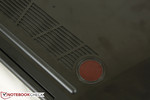
The JBL stereo speakers and subwoofer setup are similar to the Y50 and on the previous Y500 series. The Doby Digital Plus software and equalizer are oddly disabled by default, but sounds become noticeably deeper, more balanced, and expansive when enabled. Like on the older Y500 series, the bass here is strong with loud maximum volume and plenty of options and settings for games, movies, and music. The sleek and sharp red speaker grilles are more than just looks here as they perform very well for media playback. Like most media-centric notebooks, both 3.5 mm and SPDIF external solutions are supported.
Battery Life
A non-removable internal 54 Wh (7400 mAh) battery is included with every Y70 with no other available capacities. Replacing the module is possible, but it cannot be easily swapped like on the Y500 as it is behind the maintenance hatch underneath the notebook. Battery capacity here is comparable to the Acer V17 Nitro (52 Wh) and MSI GS70 (60 Wh), but it pales in comparison to thicker competitors like the Asus G750 (89 Wh) and MSI GT72 (87 Wh) and the more extreme Aorus X7 (73 Wh). In fact, battery capacity is the same as on the smaller Y50.
Runtimes are respectable and not unlike the runtimes of the similarly equipped V17 Nitro. Users can expect around 3.5 hours of constant browser use if on Power Saver mode with active integrated graphics and display brightness set close to 150 nits (setting 8/10). The Asus G750 and Alienware 17 are still the models to beat at over 5.5 hours of constant use under similar conditions. When considering the thin profile of the Y70, its small battery capacity and more demanding IPS screen, our estimated 3.5 hours of WLAN use is certainly satisfactory.
Verdict
The Lenovo Y70 Touch addresses the major issue we found on the standard Y50. The underwhelming matte TN panel on the smaller model is now a bright edge-to-edge glass IPS panel with outstanding color reproduction and contrast, especially for a gaming-oriented notebook. Viewing angles are superior than competing models that only offer TN panels while still providing wider and more accurate colors out-of-the-box. This is the kind of display option we want to see on more dedicated gaming notebooks.
There are still a number of unsavory characteristics that users should be aware of, some of which have been carried over from the Y50. While much of the base feels strong, the weaker rear corners and grilles can be easily damaged and simply do not feel as stable as larger 17.3-inch gaming notebooks like the Asus G750 or MSI GT72. Connectivity and expandability options are limited in scope, especially for a notebook in this size category where 4x USB ports, multiple video-out ports, mSATA expansions and RAID support are becoming increasingly common.
Finally, it's a shame that the notebook cannot be configured with more powerful 870M or 880M graphics, secondary internal storage options, or a higher resolution QHD display. Combining more powerful internals and sharper touchscreen options on an already attractive case would make the Y70 a much easier sell, but it's likely that Lenovo have designed the case and cooling to cater specifically for the GTX 860M and i7-4710HQ. We expect future iterations to take full advantage of the more power-efficient GTX 900M series and to improve upon certain weaker aspects of the chassis.
However, for $1399, this is still a thin and powerful gaming notebook for the size and price. Competing models will cost several hundreds more, but at the same time most of them offer dedicated SSDs and more features that the Y70 lack as described above. On the flip side, the 860M is still powerful enough for today's titles at respectable 1080p30 settings and Nvidia have yet to officially announce the 960M as of this writing, so don't expect a Y70 successor just yet. In the end, the Lenovo Y70 is an attractive barebones gaming solution - just be sure to upgrade the SSHD sometime down the line for faster system performance.


 Deutsch
Deutsch English
English Español
Español Français
Français Italiano
Italiano Nederlands
Nederlands Polski
Polski Português
Português Русский
Русский Türkçe
Türkçe Svenska
Svenska Chinese
Chinese Magyar
Magyar